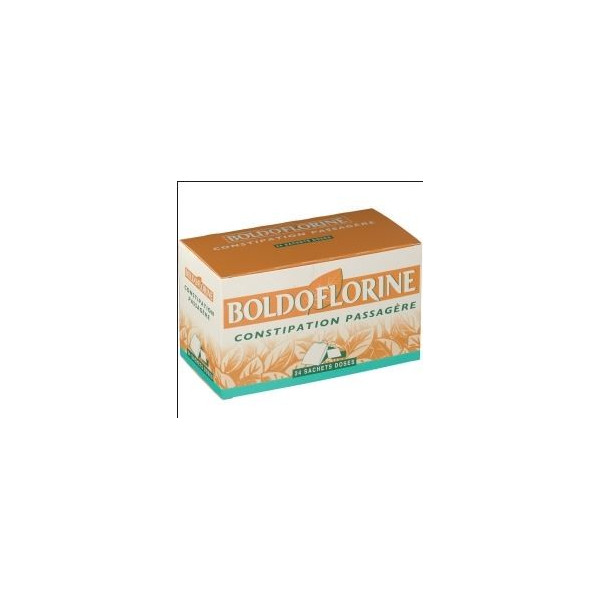1. NAME OF DRUG BOLDOFLORINE, mixture of plants for a herbal tea, sachet-dose. 2. QUALITATIVE AND QUANTITATIVE COMPOSITION Boldo (leaf): 0.105 g Rosemary (leaf): 0.140 g Senna (leaf): 0.175 g Buckthorn: 0.140 g Per single-dose sachet. To see a complete list of dilutants, see section 6.1. 3. PHARMACEUTICAL FORM Mixture of plants for a herbal tea, sachet-dose. 4. CLINICAL DATA 4.1. Therapeutic Indications Symptomatic treatment for constipation. 4.2. Dosage and how to use Standard dose: 1 sachet in a mug; 1-4 mugs per day. The herbal tea should be prepared at the time of need. Treatment should be short-term (8-10 days). 4.3. Contraindications Inflammatory organic colopathies (ulcerative colitis, Crohn's disease ...) Occlusive or subocclusive syndrome, abdominal pain syndromes of undetermined cause. Children under 12 years (without a prescription). Treatment combined with: - antiarrhythmics giving torsades de pointes: bepridil, class Ia antiarrhythmic drugs (quinidine type), sotalol, amiodarone. - lidofalzin, vincamine (non-arrhythmic drugs giving peak torsades) 4.4. Special warnings and side effects Special warnings: The drug treatment of constipation is only an additive to the hygiene treatment: - increase in fibre and drinks, - physical exercise, exemption. Prolonged use of a laxative is not recommended. For children, taking laxatives must be exceptional: it must take into account the risk of impeding the normal functioning of the exemption reflex. Prolonged intake of anthracene principles can result in two series of disorders: · “Laxative disease” with severe functional colopathy, rectocolic melanosis, hydroelectrolytic abnormalities with hypokalaemia. · A situation of dependence with regular need for laxatives, need to increase dosage and severe constipation in case of withdrawal; this dependence, which varies from one patient to another, can be created without the doctor’s knowledge. 4.5. Interactions with other drugs Combinations to avoid: Risk of hypokalaemia and therefore of drug interactions in the case of combination of a stimulating laxative with: · Antiarrhythmics giving torsades de pointes: bepridil, class Ia antiarrhythmics (type quinidine), sotalol, amiodarone. · Lidofalzin, vincamine (non-arrhythmic drugs giving peak torsades) Risk of torsades de pointes (hypokalaemia is a factor favouring as well as bradycardia and a long QT space pre-existing); use a non-stimulating laxative. Combinations to be aware of · Digitalis: hypokalemia favouring the toxic effects of digitalis. · Other hypokalaemic agents: amphotericin B (route I.V.), corticosteroids (gluco, mineralo: general route), tetracosactide, hypokalemic diuretics (alone or in combination). Increased risk of hypokalemia (additive effect). Monitoring of kalemia is essential. Use a non-stimulant laxative. 4.6. Pregnancy and breast feeding Studies in animals have not shown a teratogen effect. In the absence of a teratogenic effect in animals, a malformative effect on the human species is not expected. To date the substances responsible for malformations in the human species have been shown to be teratogenic in animals during well-conducted studies on two species. The use of senna among a small number of pregnancies has not caused any malformations or foetal toxicity to this date. However, extra studies are required to evaluate the consequences during pregnancy. Given the data, the use of senna is not recommended during pregnancy unless necessary. This medication is not recommended whilst breast-feeding. 4.7. Effects on the ability to drive and operate machinery Not applicable. 4.8. Side effects Possibility of diarrhoea, abdominal pain among elderly patients suffering from colon irritation, possibility of hypokalemia. 4.9. Overdose Symptoms: abdominal pain, diarrhoea. Course of action: stop treatment, correction of possible hydroelectrolytic disorders in the event of a very significant fluid loss. 5. PHARMACOLOGICAL PROPERTIES 5.1. Pharmaco-dynamic properties Senna and buckthorn, anthracene-type stimulant laxatives stimulate colonic motility and modify intestinal hydroelectric exchanges. Delay of effect: 8-12 hours. Boldo and rosemary are traditionally used for their choleric, cholagogue properties which help digestion. 5.2. Pharmacokinetics properties Hydroxyanthracene derivatives act on the small intestine and the colon, probably after bacterial hydrolysis in the colon. 5.3. Preclinical safety data Not known. 6. PHARMACEUTICAL DATA 6.1. List of dilutants Coriander (fruit), liquorice (root), elecampane (root), mint (leaf), apple pulp, ash (leaf), chestnut (leaf), nut (leaf). 6.2. Incompatibilities Not applicable. 6.3. Shelf life 3 years. 6.4. Storage precautions No specific storage precautions. 6.5. Nature and contents of outside packaging Box of 24 and 48 1.63g sachets (non-melting paper). 6.6. Precautions for handling and disposal No specific requirements. 7. THE MARKETING AUTHORISATION HOLDER Laboratoires DIETETIQUE ET SANTE Route de Castelnaudary BP 106 31250 Revel 8. NUMBER OF THE MARKETING AUTHORSATION HOLDER · 34009 300 366 5 5: Box of 24x1.63g sachets (non-melting paper). · 34009 300 366 6 2: ox of 28x1.63g sachets (non-melting paper). 9. START/RENEWEL DATE OF AUTHORISATION [To be completed by holder] 10. DATE OF UPDATE OF TEXT [To be completed by holder] 11. DOSIMETRY Not applicable. 12. INSTRUCTIONS FOR RADIOPHARMACEUTICAL PREPARATION Not applicable. PRESCRIPTION AND DELIVERY CONDITIONS Drug not subjected to prescription.



